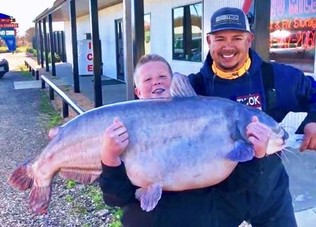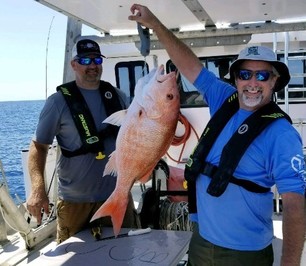In This Issue:

Summer is coming, and catfish will be just about anywhere you can find fresh water. If you plan on a catfish dinner, the 14" to 17" size are considered the best eating.
Planning to pursue catfish with a rod and reel? Take a look at these popular catfish rigs.
There are 3 cat species Texans are partial to:
-
Blue catfish get seriously large, like the 67 lb. whopper in our photo. It was pulled from Lake Tawakoni by 13-year-old Brayden Rogers of Cisco, giving him the Junior State Record. Blues go for dough balls, cut bait, jigs and minnows.
-
Flatheads are second in size to blues. Unlike other cats, they only eat live prey. They're solitary and will stake out a spot in deep water in a cove or under a tree. At night, they move into shallow areas to feed.
-
Channel catfish are active day and night. They're such fun to catch, we stock them in Neighborhood Fishin' spots across the state. Stocking has just begun, so grab the family and do some cat fishing!
Need more inspiration? Watch our video, Fishing for Cats. Wherever you fish, refer to the Outdoor Annual for bag and length limits.
|
Back to Top

Federal red snapper season opens Sat., June 1, and is projected to last 97 days. This applies to private recreational angling in federal waters, which begin 9 nautical miles from shore.
We are authorized to manage private recreational fishing for red snapper in federal waters and to determine the season’s opening date and projected season length. Red snapper season is open year-round in Texas state waters.
It's important that you download the free iSnapper app and report your catch. This will help us manage the red snapper fishery and maintain a healthy and sustainable population.
Bag and length limits differ in federal and state waters. In federal waters, the daily bag limit is 2 with a minimum length of 16". In state waters, the daily limit is 4 with a minimum length of 15".
Rigs, reefs and snapper banks offshore are the best places to catch red snapper. They can be taken using pole and line, but you must use a circle hook when using natural bait. A circle hook is made so that the point is turned back toward the shank to form a slightly circular shape. Use of these hooks has been shown to increase the survival of angler-released fish.
|
Back to Top


Each month, Texas Parks & Wildlife magazine brings you tips on where to fish, what to catch and how to catch it.
In the month of May, the weather and the water start to heat up, and bass and crappie are biting. These are 4 May hotspots to add to your list:
- Lake Travis
- Ray Roberts Lake
- Hubbard Creek
- South Coast
Pleasure boat traffic also heats up in May, especially during Memorial Weekend. To avoid increased boat wave action, fish early or late afternoon into evening.
|
Back to Top

If you fish with bait shrimp, it's illegal to use anything but native shrimp from the Gulf.
Imported shrimp has been found to carry a virus that causes white-spot syndrome, which can quickly kill our native shrimp, crayfish and crabs. It does not affect humans.
Shrimp from any non-Gulf state or any other country is considered imported and cannot be used as bait. Familiarize yourself with common imported shrimp and the 4 acceptable types of bait shrimp. If you buy frozen shrimp, check the origin on the package.
Many people, fish and birds depend on our shrimp, crayfish and crab populations. Don't let an imported virus wipe them out. Pay attention to any bait shrimp you buy – check its origin first.
|
Back to Top


When the Llano River flooded last year, it displaced many fish, including recently reestablished Guadalupe bass. We are happy to report that Llano River fish populations are recovering.
During a March sampling, the largest populations of fish were on the stretch of the Llano River near the city of Junction and on the South Llano River.
“This stretch appears to be less affected by the flood. We caught multiple species of minnows, suckers and game fish, including largemouth bass and our state fish, Guadalupe bass. Anglers visiting the area this year will likely have higher fishing success focusing on this stretch of the river,” said John Botros, River Access Program Coordinator.
Landowners can help the Llano River recover by taking care of areas adjacent to the river. This includes letting trees and other woody debris remain in place and planting native vegetation along the banks.
|
Back to Top

The official state fish of Texas needs some help. Guadalupe bass can be found in the cool, clear waters of the Texas Hill Country, and we have identified the fish as a Species of Greatest Conservation Need. Because of increased water demands, habitat loss and many other factors, Guadalupe bass have been eliminated from several Hill Country rivers.
That’s why our nonprofit funding partner, Texas Parks and Wildlife Foundation, is partnering on the Guadalupe Bass Restoration Initiative. Through fish habitat restoration, invasive species management, and conservation stockings, Guadalupe bass are being restored to their native rivers and streams.
You can help support the state fish of Texas by becoming a member today.
|
Back to Top

Good news from the invasive species fronts! Giant salvinia appears to have been eradicated from Lake Fork and Lake Athens.
“We weren’t sure if eradication was even possible. This success goes to show you that with early detection and a coordinated, rapid response between TPWD, local organizations, anglers and boaters, we can effectively fight back against this invasive plant,” said John Findeisen, Aquatic Habitat Enhancement Team Lead.
Flooding and cold spells in the past year have also curbed growth of giant salvinia in East Texas. Two years ago, 6,000 acres of Caddo Lake was covered by the invasive weed. Today, our biologists report that giant salvinia at Caddo Lake has been reduced to just over 1,500 acres.
On the zebra mussels front, recent sampling found no new infested lakes, and zebra mussels have not been found in a new river basin since June 2017.
Invasive species may be down, but they’re not out. Be vigilant – always clean, drain and dry your fishing gear, as well as your boat and trailer, before using it in another lake. Protect the lakes you love.
|
Back to Top

Many colonial waterbirds come to the Texas coast to nest. It's illegal to disturb them, and we caution you to avoid nesting waterbirds.
Watch for yellow signs that identify "rookery" islands, the inshore islands where birds live together to raise young from Feb. through Aug.
These waterbirds are very sensitive to manmade disturbances, which can lead to nest failure, and in some cases, total abandonment of an island. More than half of colonial waterbirds are experiencing major population declines. Give them a break and give them their space.
|
Back to Top

In honor of Texas law enforcement officers, anyone who holds an active peace officer license can fish without a fishing license this weekend. Everyone can fish for free on June 1, Free Fishing Day.
Back to Top
|